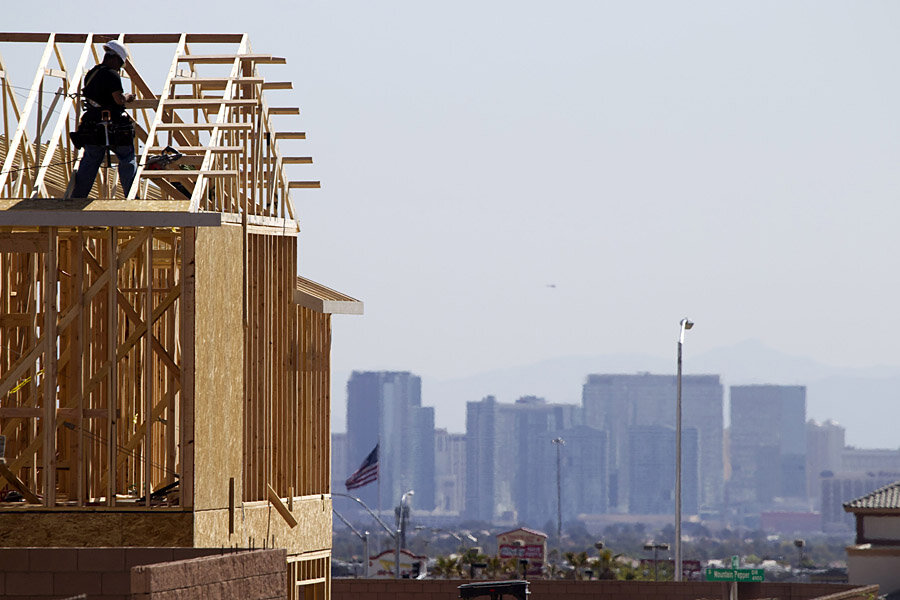Housing starts plunge in August. Weak wages to blame?
Loading...
| Washington
US home construction plunged in August, led by steep decline in the pace of building apartments.
Construction fell 14.4 percent in August to a seasonally adjusted annual rate of 956,000 homes, the Commerce Department said Thursday. This reverses the sharp gains in July when the rate of new construction rose to 1.12 million homes, the highest annual rate since 2007.
Last month's decrease primarily came from builders starting fewer apartment complexes, which plummeted 31.5 percent compared to July. Apartments have propelled much of the growth in residential construction over the past year, but the pace has been volatile from month to month. Apartment starts surged 51 percent in July.
"Some of the recent volatility in housing starts has undoubtedly been related to abnormally wet weather in many areas over the early summer and then a consequent unsustainable rebound in activity as conditions improved and catch-up occurred," Joshua Shapiro, an economist with MFR, Inc., wrote via e-mailed analysis. "It is therefore to discern the near-term underlying trend of overall starts, although we suspect it is still broadly flat."
"Because the housing starts data are volatile on a monthly basis, these data do not change our view that a moderate housing recovery remains on track," he added. "One way to see this is by looking at y/y changes; single-family starts rose 4.2% y/y in August, while multifamily starts rose 16.8%.
In August, the building of single-family houses fell 2.4 percent.
Applications for building permits, a sign of future activity, dipped 5.6 percent to an annual rate of 998,000.
Apartment construction has surged 19.2 percent in the past 12 months. Meanwhile, single-family starts have risen just 4.2 percent. The shift among builders to increased apartment building is a sign that a rising share of Americans will be renters, rather than homeowners.
"Housing starts totaled 956k in August, down from 1.117million in July and below our (1.010 million) and consensus (1.037 million) expectation," Dean Maki, an economist with Barclays Research, writes via e-mailed analysis. "Housing starts had surged in July, driven in large part by the volatile multifamily sector, and that sector also led the August decline by falling 31.7% m/m, to 313k (from 458k). Single-family starts fell only 2.4% m/m, to 643k (from 659k), retracing only a small portion of the July surge. Permits also fell in August, and this was also led by the multifamily sector, which fell to 372k from 426k, while single-family permits fell only modestly (626k from 631k)."
"Because the housing starts data are volatile on a monthly basis, these data do not change our view that a moderate housing recovery remains on track," he added. "One way to see this is by looking at year-over-year changes; single-family starts rose 4.2% year-over-year in August, while multifamily starts rose 16.8%."
The growing preference for rentals likely reflects the sluggish, five-year economic recovery. Most incomes remain below their pre-recession levels, making it harder for families to save for a down payment and qualify for a mortgage. The Census Bureau said this week that median household incomes were $51,939 in 2013. Adjusting for inflation, that's 8 percent lower than in 2007, when the recession began.
Still, solid job growth for much of 2014 has increased the total number of paychecks in the economy. When more people are working, that should provide a boost for home construction.
One measure of building confidence has been steadily improving for the past four months.
The National Association of Home Builders/Wells Fargo builder sentiment index rose in September to 59, the highest reading since November 2005. Readings above 50 indicate more builders view sales conditions as good rather than poor.
Builders see sales activity and traffic from would-be buyers as improving. Still, interest from first-time buyers continues to lag historical averages.
New homes are selling for an average price of $339,100, according to the Commerce Department. Those prices, coupled with weak wage growth, have made affordability a problem for potential buyers seeking a new home.
But economists are still looking for a rebound heading into the tail end of the year. Job gains through August have averaged more than 215,000 a month this year.
Though new homes represent only a fraction of the housing market, they have an outsize impact on the economy. Each home built creates an average of three jobs for a year and generates about $90,000 in tax revenue, according to data from the Home Builders.







